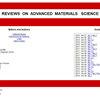Couple effects of multi-impact damage and CAI capability on NCF composites
IF 3.9
4区 材料科学
Q2 MATERIALS SCIENCE, MULTIDISCIPLINARY
引用次数: 0
Abstract
In this study, the mechanical properties of non-crimp fabric (NCF) composite laminates under low-velocity impact and compression after impact (CAI) tests were studied by Scanning electron microscopy (SEM) and Digital image correlation (DIC) techniques. The impact response under different impact times, impact angles, and impact distance is studied. Similarly, in CAI test, DIC technique is used to reveal the whole process of NCF composite compression failure, and SEM is used to reveal the microscopic failure form. The experimental results show that the impact damage process of NCF composites has strong directivity. The concrete manifestation is that the internal failure will extend along the paving direction at the failure layer. The peak load generated under 20 J impact energy is about 1/2 of that under 40 J impact energy. The impact distance is one of the important factors affecting the coupling effect of multiple impacts, and the impact angle has little effect on the internal damage extension. The proportion of internal damage area also supports the relevant view, that is, the average difference in the proportion of internal damage area under different impact distance is about 5%, while the average difference in the proportion of internal damage area under different impact angles is about 3%. During the compression process, the main failure mode is shear failure and the failure mode is brittle fracture. The oblique fracture occurs only when the oblique is 45° and the impact distance is large (50 mm). The impact angle has little effect on the residual compression performance of NCF.多重冲击损伤和 CAI 能力对 NCF 复合材料的耦合效应
本研究采用扫描电子显微镜(SEM)和数字图像相关(DIC)技术,研究了低速冲击和冲击后压缩(CAI)试验下非卷曲织物(NCF)复合材料层压板的机械性能。研究了不同冲击时间、冲击角度和冲击距离下的冲击响应。同样,在 CAI 试验中,DIC 技术用于揭示 NCF 复合材料压缩破坏的全过程,扫描电子显微镜用于揭示微观破坏形态。实验结果表明,NCF 复合材料的冲击破坏过程具有很强的指向性。具体表现为内部破坏沿破坏层的铺装方向延伸。在 20 J 冲击能量下产生的峰值载荷约为 40 J 冲击能量的 1/2。冲击距离是影响多次冲击耦合效应的重要因素之一,而冲击角度对内部破坏扩展影响不大。内部损伤面积比例也支持相关观点,即不同冲击距离下内部损伤面积比例的平均差异约为 5%,而不同冲击角度下内部损伤面积比例的平均差异约为 3%。在压缩过程中,主要的破坏模式是剪切破坏,破坏方式是脆性断裂。只有当斜度为 45°、冲击距离较大(50 毫米)时,才会发生斜断裂。冲击角度对 NCF 的残余压缩性能影响不大。
本文章由计算机程序翻译,如有差异,请以英文原文为准。
求助全文
约1分钟内获得全文
求助全文
来源期刊

Reviews on Advanced Materials Science
工程技术-材料科学:综合
CiteScore
5.10
自引率
11.10%
发文量
43
审稿时长
3.5 months
期刊介绍:
Reviews on Advanced Materials Science is a fully peer-reviewed, open access, electronic journal that publishes significant, original and relevant works in the area of theoretical and experimental studies of advanced materials. The journal provides the readers with free, instant, and permanent access to all content worldwide; and the authors with extensive promotion of published articles, long-time preservation, language-correction services, no space constraints and immediate publication.
Reviews on Advanced Materials Science is listed inter alia by Clarivate Analytics (formerly Thomson Reuters) - Current Contents/Physical, Chemical, and Earth Sciences (CC/PC&ES), JCR and SCIE. Our standard policy requires each paper to be reviewed by at least two Referees and the peer-review process is single-blind.
 求助内容:
求助内容: 应助结果提醒方式:
应助结果提醒方式:


